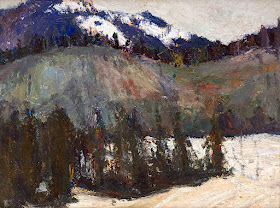JAN STANISLAWSKI (1860-1907),
Gerlachovský štít (2,654 m - 8,709 ft)
Slovakia- Poland
In High Tatras in winter, oil on canvas, 1891
Gerlachovský štít (2,654 m - 8,709 ft), Gerlach Peak in english, is the highest peak in the High Tatras, in Slovakia, and in the whole 1,500 km (930 mi) long Carpathian mountain chain. The pyramidal shape of the massif is marked by a huge cirque. Despite its relatively low elevation, the about 2,000 m vertical rise from the valley floor makes Gerlachovský štít soar. Mistaken for an average mountain in the rugged High Tatras range in the more distant past, it has since played a symbolic role in the eyes of the rulers and populations of several Central European nations, to the point that between the 19th and mid-20th century, it had four different names with six name reversals. It managed to be the highest mountain of the Kingdom of Hungary, and of the countries of Czechoslovakia and Slovakia within the span of only about two decades of the 20th century.
Gerlachovský štít shares its geology and ecology with the rest of the High Tatras, but provides a worthwhile environment for biologists as the highest ground anywhere in Europe north of the parallel linking approximately Munich, Salzburg, and Vienna. With the travel restrictions imposed by the Eastern Bloc, the mountain was particularly treasured as the loftiest point available to climb to by Czechs, East Germans, Hungarians, Poles, and Slovaks. It continues to attract its share of visitors although the local authorities have been continually adding new restrictions on access.
Climbing
The High Tatras is truly an alpine rock climber’s paradise since there are no nasty glaciers about and the snow is mostly gone by June, though it may linger in some of the shaded valleys until late August. There are literally hundreds of alpine rock and face climbs here and most of them have never been done by westerners even 10 years after the fall of the wall. Most importantly the rock quality is on a par with Yosemite and the routes are well established and protected. Only members of a national UIAA club are allowed to climb the peak on their own. Other visitors have to take a certified mountain guide. The two easiest routes, usually up the Velická próba and down the Batizovská próba named after their respective valleys, are protected by chains.Technically only a grade II to III climb when not snow covered it benefits greatly from a very well maintained mountain trail that leads to the summit along a standard route.
The painter
Jan Stanisławski was a Polish modernist painter, art educator, founder and member of various innovative art groups and literary societies. He began to learn painting at the art studio in Warsaw which later gave rise to the School of Fine Arts, under Wojciech Gerson. In 1885, he continued his studies in Paris under Charles Emile Auguste Durand. While based in Paris, he travelled much, visiting Italy, Spain, Switzerland, Germany, Austria and eastern Galicia.
His early works were exhibited at the inauguration of the Salon du Champ-de-Mars in Paris in 1890 and at the Kraków Society of Friends of Fine Arts in 1892. In the 1890s, he travelled extensively and his sketchbooks filled up with drawings from Berlin, Dresden, Prague, Kraków, and various places in Ukraine. In 1897, he initiated and helped organise the Separate Exhibition of Painting and Sculpture at Kraków’s Cloth Hall. That year, he became a teacher of landscape painting at the School of Fine Arts in Kraków, and in 1906 – after the school was upgraded to an academy in 1900 – was granted full professorship and also taught at Teodor Axentowicz’s Private School of Painting and Drawing for Women and at Teofila Certowicz’s Art School for Women in Kraków.
He co-founded the Society of Polish Artists "Sztuka" ("Art") in Kraków in 1897. In 1898, he became a member of the Viennese Secession, and his works were exhibited among theirs in 1901, 1902 and 1905. In 1901, he became a founding member of the Polish Applied Arts Society. He worked in the Wawel Castle Reconstruction Committee and was involved in the activities of the Green Balloon (Zielony Balonik) Cabaret. After his death, two exhibitions were opened at the Palace of Art by the Kraków Society of Friends of Fine Arts in November 1907, one to show 154 of his oil paintings, as well as drawings and watercolours, and the other to present the works of his numerous outstanding students.
_______________________________
2017 - Wandering Vertexes...
by Francis Rousseau
